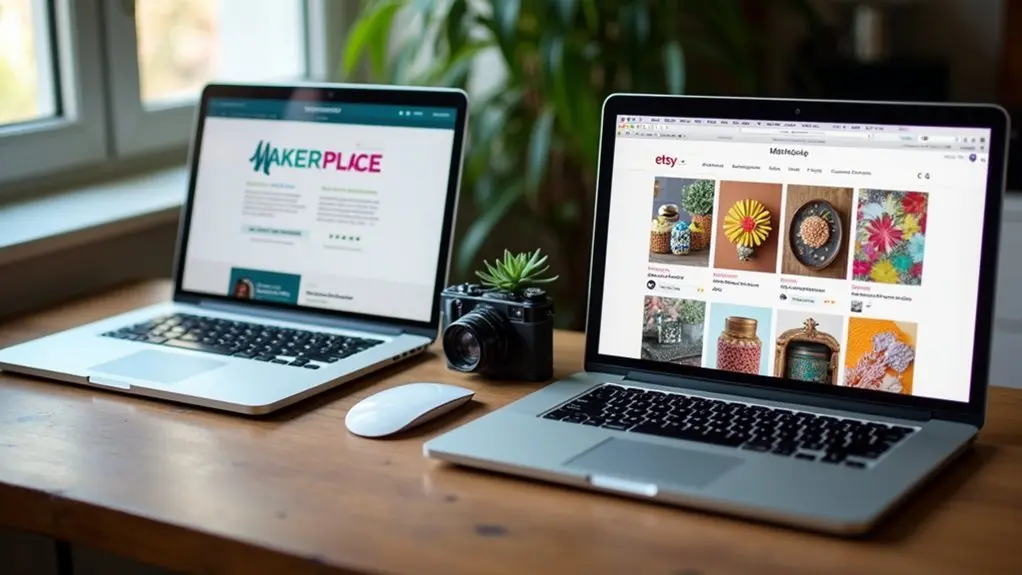GoImagine offers lower fees with a 5% transaction charge and 2.9% processing fee, plus ethical commitments like donating 2% of sales to children’s charities. In contrast, Etsy has a broader reach with 400 million visitors and higher fees, including a 6.5% transaction fee. GoImagine has a user-friendly interface and reduced competition with around 480 sellers, while Etsy provides extensive ecommerce tools and attracts 96 million active buyers. Exploring further reveals more about these platforms’ unique offerings.
Key Takeaways
- Etsy charges higher fees, including a 6.5% transaction fee and a $0.20 listing fee per item.
- Go Imagine’s lower fees include a 5% transaction fee and affordable membership plans starting at $2.50 for 20 listings.
- Etsy attracts 400 million monthly visitors, offering broader visibility but intense competition with over 9 million sellers.
- Go Imagine emphasizes ethical practices, donating 2% of each purchase to children’s charities and supporting 100% handmade U.S. products.
- Etsy’s extensive tools and marketing integrations contrast with Go Imagine’s community-driven visibility and streamlined seller support.
Fee Structures and Cost Comparisons
In analyzing the fee structures of Go Imagine and Etsy, it is evident that cost considerations play an essential role in determining platform choice for sellers.
Etsy imposes a listing fee of $0.20 per item, a transaction fee of 6.5% on the total order amount, and a payment processing fee of 3% + $0.25 in the U.S.
Etsy charges a $0.20 listing fee per item, plus a 6.5% transaction and a 3% + $0.25 processing fee.
Go Imagine, conversely, offers a lower transaction fee of 5% on total sales and a processing fee of 2.9% + $0.30 per transaction through Stripe.
Additionally, Go Imagine’s tiered membership plans, starting at $2.50 per month for 20 listings, provide an economical option for sellers with fewer items.
User Interface and Setup Process
Although both GoImagine and Etsy offer user-friendly interfaces, there are notable differences in their setup processes and customization options.
GoImagine emphasizes a streamlined membership signup, enabling sellers to swiftly list products with a user interface designed for ease of use. Its direct integration with Stripe from the dashboard enhances the transaction process.
In contrast, Etsy’s setup allows rapid account creation and product listing but limits branding options without an Etsy Plus subscription. However, Etsy’s Shop Manager provides extensive tools for managing listings, analytics, and advertising, accommodating both novice and seasoned sellers.
While GoImagine’s interface prioritizes handmade goods, Etsy requires more customization effort for branding and marketing strategies, underscoring differing priorities in user interface design and ease of use.
Traffic and Visibility Analysis
Etsy’s platform, with its 400 million monthly visitors, offers a substantial advantage in visibility over GoImagine, which garners approximately 245,000 monthly visits.
This disparity suggests that Etsy’s sellers benefit from broader audience engagement, particularly in key markets like the U.S. and the U.K., while GoImagine’s users may need to employ more aggressive self-promotion strategies to achieve similar exposure.
Despite this, GoImagine presents an opportunity for early adopters to establish a presence in its evolving marketplace dedicated to handmade items.
Monthly Visit Comparison
When comparing monthly visits, Etsy considerably outpaces GoImagine with 400 million visitors compared to GoImagine’s 245,000. This stark difference highlights Etsy’s advantage in providing sellers with a built-in audience and significant exposure opportunities. The audience size directly impacts sellers’ potential visibility and sales prospects, making Etsy a more attractive option for those seeking immediate market reach.
| Platform | Monthly Visits | Built-in Audience |
|---|---|---|
| Etsy | 400 million | Yes |
| GoImagine | 245,000 | No |
Etsy’s dominance is further exemplified by its established traffic sources, with 56.86% from the U.S. and 9.25% from the U.K. In contrast, GoImagine relies on community-driven efforts and has a smaller, growing audience. This data illustrates the challenges GoImagine faces in competing with Etsy’s established market presence.
Audience Engagement Strategies
How do platforms like Etsy and GoImagine strategize to engage their audiences and increase visibility for sellers?
Etsy leverages its substantial 400 million monthly visitors to enhance audience engagement by providing a centralized space for community interaction, which can boost seller visibility. The platform’s significant traffic from the U.S. and U.K. requires sellers to focus on these markets.
In contrast, GoImagine, with 245,000 monthly visits, fosters engagement through a community-centric approach, promoting networking among creators.
While Etsy’s sellers face intense competition and need effective marketing strategies, GoImagine’s users often rely on self-marketing to enhance visibility.
Both platforms offer customer support, but Etsy’s commercial environment contrasts with GoImagine’s emphasis on community, creating distinct engagement dynamics for sellers.
Seller Support and Community Engagement
In the realm of seller support and community engagement, an analysis reveals distinct approaches between GoImagine and Etsy.
GoImagine adopts a seller-first philosophy, prioritizing community engagement and valuing seller feedback highly. This platform fosters collaboration through direct communication channels and responsive support services.
Conversely, Etsy provides support via email, chat, and a help center, yet its policies are perceived as more rigid, occasionally resulting in shop shutdowns for policy breaches. Both platforms maintain community forums, though Etsy’s vast seller base can cause support delays.
GoImagine further distinguishes itself by allowing sellers to set personalized policies, enhancing seller-buyer relationships. Additionally, GoImagine’s commitment to community involvement is evident through its donation of 2% from each purchase to charitable causes.
Ethical Commitments and Community Impact
GoImagine’s ethical commitments and community impact are underscored by its dedication to social responsibility, as evidenced by its policy of allocating 2% of every purchase to support children in need. This initiative reflects GoImagine’s emphasis on a caring economy, promoting ethical practices and supporting small businesses. The platform’s exclusive focus on handmade items aligns with its mission to foster authentic craftsmanship and ethical purchasing. In addition, GoImagine actively engages in charitable initiatives, enhancing its community impact. In contrast to Etsy’s broader market approach, GoImagine’s model supports a community-focused environment.
| Aspect | GoImagine | Etsy |
|---|---|---|
| Social Responsibility | 2% to children in need | Not specified |
| Product Focus | Handmade items | Variety |
| Community Engagement | Networking among creators | Community forums |
| Charitable Initiatives | Active involvement | Limited |
| Ethical Practices | High priority | Medium priority |
Marketplace Size and Competition
In comparing marketplace size, Etsy attracts over 400 million monthly visitors with 96 million active buyers, while GoImagine sees approximately 245,000 visits, reflecting its ongoing growth phase.
Etsy’s environment, with over 9 million sellers, creates a saturated and competitive setting, particularly in the handmade segment, whereas GoImagine’s smaller pool of around 480 sellers offers reduced competition for visibility.
This disparity presents differing strategic considerations for sellers evaluating the potential reach and seller density on each platform.
User Base Comparison
Etsy and GoImagine present contrasting profiles regarding marketplace size and competition.
In a user base comparison, Etsy’s platform is significantly larger, with over 400 million monthly visitors and 96 million active buyers, making it a formidable environment for sellers. This extensive reach guarantees built-in traffic but also intensifies competition due to millions of listings.
On the other hand, GoImagine is emerging as an Etsy alternative, with a smaller user base of approximately 245,000 monthly visits and around 480 sellers. This smaller scale offers reduced competition, allowing sellers more visibility, although it necessitates proactive traffic generation efforts.
Both platforms maintain strict handmade policies, but GoImagine’s exclusive focus on handmade items caters to a niche audience, contrasting with Etsy’s broader product offerings.
Seller Density Insights
How does the density of sellers impact competition and visibility on a marketplace?
On Etsy, a high seller density with over 9 million sellers creates significant competition, making it difficult for individual listings to gain visibility. Despite its extensive reach of 400 million monthly visits, the sheer volume of listings can overshadow new entrants.
Conversely, Go Imagine’s marketplace, with only 480 sellers, offers a less saturated environment, reducing competition and enhancing visibility for handmade items. This smaller seller density allows for personalized interactions and niche market opportunities.
- Etsy Seller Density: Over 9 million sellers
- Go Imagine Seller Density: Approximately 480 sellers
- Etsy Monthly Visits: 400 million
- Go Imagine Monthly Visits: 245,000
These dynamics highlight the trade-offs between reach and competition in online marketplaces.
Competitive Landscape Overview
While the marketplace size can markedly impact competition for sellers, GoImagine and Etsy showcase contrasting settings in this regard. Etsy, with over 400 million monthly visitors and 96 million active buyers, dominates in scale compared to GoImagine’s 245,000 monthly visits. This difference contributes to a highly saturated competitive environment on Etsy, featuring over 9 million sellers and posing visibility challenges for newcomers. Conversely, GoImagine’s smaller scale, with 480 sellers, offers reduced competition but also a smaller audience.
| Marketplace | Monthly Visitors | Active Buyers | Sellers |
|---|---|---|---|
| Etsy | 400 million | 96 million | 9 million |
| GoImagine | 245,000 | N/A | 480 |
GoImagine’s lower transaction fees of 5% compared to Etsy’s 6.5% make it a cost-effective choice, especially appealing for those valuing ethical operations and community focus.
Handmade Policies and Eligibility
Both GoImagine and Etsy enforce stringent handmade policies to preserve the authenticity and integrity of their marketplaces.
GoImagine mandates that sellers be U.S. residents, with products being 100% handmade by the seller or with minimal assistance, ensuring strict eligibility criteria.
Etsy, in contrast, allows sellers from over 50 countries and requires that items be made or designed by the seller.
Both platforms aim to prevent mass-produced items from infiltrating their handmade markets.
- GoImagine: U.S. residents only, 100% handmade products.
- Etsy: Sellers from 50+ countries, items must be made or designed by the seller.
- Feedback: GoImagine values seller feedback for policy improvements.
- Policy enforcement: Etsy may deactivate listings for policy violations, affecting seller visibility.
Ecommerce Tools and Seller Resources
Charting the terrain of ecommerce tools and seller resources reveals notable differences between GoImagine and Etsy. GoImagine offers a user-friendly interface for managing listings and sales, appealing to those seeking simplicity.
In contrast, Etsy’s Shop Manager provides advanced analytics and advertising options, making it suitable for sellers desiring thorough eCommerce functionalities. Etsy’s integrated marketing tools, like Etsy Ads, and external app integrations further expand its capabilities.
Both platforms facilitate product listings, but GoImagine incorporates listing fees within its affordable membership plans, starting at $2.50 for 20 listings. Conversely, Etsy charges $0.20 per listing plus transaction fees.
Seller resources are more extensive on Etsy, featuring articles, videos, and community forums to aid in shop optimization and platform navigation.
Advantages of GoImagine
GoImagine presents several distinct advantages that cater to cost-conscious and ethically minded sellers. One of the primary benefits is its lower transaction fee of 5%, compared to the 6.5% fee charged by an Etsy shop, providing sellers with a more cost-effective platform.
Moreover, GoImagine offers flexible membership plans, starting with a free tier that allows 12 listings, enabling sellers to choose plans that align with their business needs.
The platform’s emphasis on ethical practices is evident, as 2% of every purchase is donated to assist children in need. Additionally, GoImagine supports a dedicated audience focused on handmade items, reducing competition with mass-produced goods.
- Lower transaction fees at 5%
- Flexible membership plans
- 2% donations for children
- Niche market for handmade items
Benefits of Choosing Etsy
While choosing an online marketplace, sellers may find Etsy’s established infrastructure particularly advantageous. With over 400 million monthly visitors, Etsy offers a vast built-in audience, greatly enhancing visibility and sales potential.
The platform’s all-encompassing eCommerce features, including a user-friendly Shop Manager and analytics tools, enable sellers to optimize their shops efficiently. Additionally, Etsy simplifies sales tax compliance by integrating tax collection into its system, reducing the administrative burden for sellers.
Etsy’s diverse product categories, supporting handmade, vintage, and craft supplies, attract a broad spectrum of buyers. Moreover, the active community engagement, facilitated by forums and seller resources, fosters collaboration and knowledge sharing.
This robust ecosystem positions Etsy as a compelling choice for online sellers seeking growth and community support.
Frequently Asked Questions
What Is the Breakdown of All Etsy Fees?
Etsy charges a $0.20 listing fee per item. Transaction fees are 6.5% on the order total. Etsy payment processing fees for U.S. sellers are 3% plus $0.25 per transaction. No monthly fees for standard accounts.
Does Etsy Take 30%?
Etsy’s selling fee structure does not entail a flat 30% fee. Instead, it comprises listing, transaction, and payment processing fees. Sellers may perceive total costs approaching 30% when considering additional expenses like Etsy Ads and shipping.
Does Etsy Take 25%?
Etsy commission does not equate to a flat 25%. Instead, sellers face multiple fees—listing, transaction, and payment processing—that cumulatively impact seller profits. These costs vary, often resulting in significant deductions from overall earnings, especially for low-priced items.
What Percentage Cut Does Etsy Take?
Etsy revenue is derived from several fees that impact seller profits. Typically, Etsy takes a cut of 9.5% from each sale, combining a 6.5% transaction fee and approximately 3% payment processing fee, excluding additional listing fees.
Conclusion
In evaluating GoImagine and Etsy, the analysis reveals distinct differences in fee structures, user interfaces, and seller support. GoImagine’s ethical commitment and community impact are significant, while Etsy offers higher traffic and visibility. Both platforms provide unique ecommerce tools and seller resources, tailored to their respective audiences. Ultimately, the choice between GoImagine and Etsy depends on the seller’s priorities, whether valuing ethical practices and community contributions or preferring greater exposure and established market presence.




